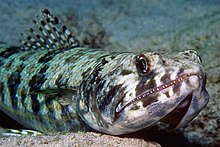Synodus intermedius
| Synodus intermedius | |
|---|---|
 |
|
| Scientific classification | |
| Kingdom: | Animalia |
| Phylum: | Chordata |
| Class: | Actinopterygii |
| Order: | Aulopiformes |
| Family: | Synodontidae |
| Genus: | Synodus |
| Species: | S. intermedius |
| Binomial name | |
|
Synodus intermedius (Spix & Agassiz, 1829) |
|
| Synonyms | |
|
|
Synodus intermedius, the sand diver, is a species of fish in the lizardfish family, Synodontidae, a basal ray-finned fish in the class Actinopterygii. The etymology of Synodus is of Greek origin: "syn", symphysis or grown together, and "odous" which means teeth. Sand divers inhabit subtropical marine ecosystems, (37°N-17°N), including sandy bottom areas on continental shelves, coral reefs, estuaries, bays, and reef structures. They are demersal or benthic fish, which means they live on or close to the sea bed. Distribution ranges from the northern Gulf of Mexico south to the Guianas, and western Atlantic north to North Carolina and Bermuda. They are a common lizardfish in the West Indies. They grow to approximately 40 cm (16 in) total length, and weigh around 1 kg (2.2 lb).
The trunk of sand divers is a pallid color, ranging from gray to brownish gray with mottling on the head and trunk grading to a whitish underbelly. They have variable markings, including a black patch on the shoulder girdle, reddish brown vertical bars across the back, and thin yellow-gold striped lateral lines running from behind the gill flap or operculum to the base of the tail or caudal fin. They are able to alter their color, becoming paler or darker to blend with the background.
Lizardfishes are aulopiforms in the order Synodontidae which is represented in the western Atlantic by 3 genera: Synodus, comprising 6 species, Saurida, comprising 4 species, and Trachinocephalus which includes a single species.
...
Wikipedia
